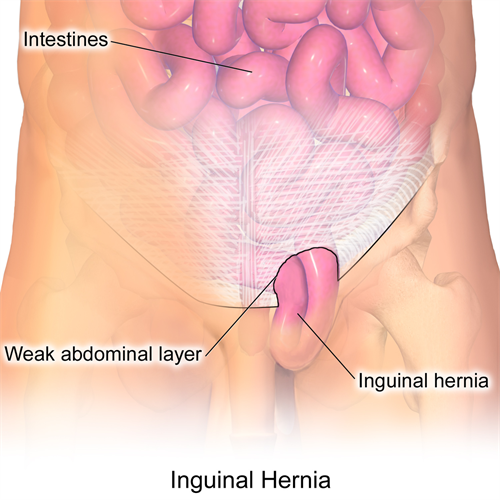Inguinal Hernia
In an inguinal hernia, abdominal fat or a loop of small intestine enters the inguinal canal, a tubular passage through the lower layers of the abdominal wall. A hernia occurs when part of an internal organ (usually the small intestine) protrudes through a weak point or tear in the peritoneum, the thin muscular wall holding the abdominal organs in place resulting in a bulge. In men, inguinal hernias typically develop in the groin area near the scrotum, on one or both (double hernia) sides.
Hernia repairs are common—more than one million hernia repairs are performed each year in the U.S. Approximately 800,000 are to repair inguinal hernias and the rest are for other types of hernias. Repair of Inguinal hernias is among the most frequently performed surgeries in the U.S.

Image Credit: "Blausen 0560 InguinalHernia" by BruceBlaus
Signs and Symptoms
Symptoms of an inguinal hernia include:
- A small bulge in one or both sides of the groin that may increase in size and disappear when lying down; in males, it can present as a swollen or enlarged scrotum
- Discomfort or sharp pain-especially when straining, lifting, or exercising-that improves when resting
- A feeling of weakness or pressure in the groin
- A burning, gurgling, or aching feeling at the bulge
Incidence
An inguinal hernia may arise at any time from infancy to adulthood. However, it is far more common in males with a lifetime risk of 27% in men and 3% in women. Some individuals are born with weak abdominal muscles and are more likely to develop a hernia. Others are caused by excessive strain on the abdominal wall from heavy lifting, weight gain, coughing, or difficulty with bowel movements and urination.
Types
Direct Inguinal Hernias
Direct inguinal hernias are caused by connective tissue degeneration of the abdominal muscles, which causes weakening of the muscles during the adult years. Direct inguinal hernias occur only in males. The hernia involves fat or the small intestine sliding through the weak muscles into the groin. A direct hernia develops gradually because of continuous stress on the muscles.
Any activity or condition which increases pressure in the intra-abdominal cavity may contribute to the formation of a hernia, including:
- Obesity
- Heavy lifting
- Coughing
- Straining with urination or defecation
- Chronic obstructive pulmonary disease (COPD)
- Ascites
- Peritoneal dialysis
- Ventriculoperitoneal shunt
Indirect Inguinal Hernias
Indirect inguinal hernias are congenital hernias and are much more common in males than females because of the way males develop in the womb. In a male fetus, the spermatic cord and both testicles-starting from an intra-abdominal location-normally descend through the inguinal canal into the scrotum, the sac that holds the testicles.
Sometimes the entrance of the inguinal canal at the inguinal ring does not close as it should just after birth, leaving a weakness in the abdominal wall. Fat or part of the small intestine slides through the weakness into the inguinal canal, causing a hernia. In females, an indirect inguinal hernia is caused by the female organs or the small intestine sliding into the groin through a weakness in the abdominal wall.
Indirect hernias are the most common type of inguinal hernia. Premature infants are especially at risk for indirect inguinal hernias because there is less time for the inguinal canal to close.
"Incarcerated" and "Strangulated" Inguinal Hernias
An incarcerated inguinal hernia is a hernia that becomes stuck in the groin or scrotum and cannot be massaged back into the abdomen. An incarcerated hernia is caused by swelling and can lead to a strangulated hernia, in which the blood supply to the incarcerated small intestine is jeopardized. A strangulated hernia is a serious condition and requires immediate medical attention. Symptoms of a strangulated hernia include:
- Extreme tenderness and redness in the area of the bulge
- Sudden pain that worsens in a short period of time
- Fever
- Rapid heart rate
Left untreated, nausea, vomiting, and severe infection can occur. If surgery is not performed right away, the condition can become life threatening, and the affected intestine may die. Then that portion of the intestine must be removed.
Diagnosis
To diagnose inguinal hernia, the doctor takes a thorough medical history and conducts a physical examination. The person may be asked to stand and cough so the doctor can feel the hernia as it moves into the groin or scrotum. The doctor checks to see if the hernia can be gently massaged back into its proper position in the abdomen.
Treatment
In adults, inguinal hernias that enlarge, cause symptoms, or become incarcerated are treated surgically. In infants and children, inguinal hernias are always operated on to prevent incarceration from occurring. Surgery is usually done on an outpatient basis. Recovery time varies depending on the size of the hernia, the technique used, and the age and health of the patient. The two main types of surgery for hernias are as follows:
Open Hernia Repair
In open hernia repair, also called herniorrhaphy, a person is given local anesthesia in the abdomen or spine to numb the area, general anesthesia to sedate or help the person sleep, or a combination of the two. Then the surgeon makes an incision in the groin, moves the hernia back into the abdomen, and reinforces the muscle wall with stitches. Usually the area of muscle weakness is reinforced with a synthetic mesh or screen to provide additional support-an operation called hernioplasty.
Laparoscopic Inguinal Hernia Repair
Laparoscopic surgery is performed using general anesthesia. The surgeon makes several small incisions in the lower abdomen and inserts a laparoscope-a thin tube with a tiny video camera attached to one end. The camera sends a magnified image from inside the body to a monitor, giving the surgeon a close-up view of the hernia and surrounding tissue. While viewing the monitor, the surgeon uses instruments to carefully repair the hernia using synthetic mesh.
People who undergo laparoscopic surgery generally experience a somewhat shorter recovery time. However, the doctor may determine laparoscopic surgery is not the best option if the hernia is very large or the person has had pelvic surgery.
Most adults experience discomfort after surgery and require pain medication. Vigorous activity and heavy lifting are restricted for several weeks. The doctor will discuss when a person may safely return to work. Infants and children also experience some discomfort but usually resume normal activities after several days.
Potential Complications
Surgery to repair an inguinal hernia is generally safe and complications are uncommon. Knowing possible risks allows patients to report postoperative symptoms to their doctor as soon as they occur.
-
Risk of general anesthesia. Before surgery, the anesthesiologist-a doctor who administers anesthesia-reviews the risks of anesthesia with the patient and asks about medical history and allergies to medications. Complications most likely occur in older people and those with other medical conditions. Common complications include nausea, vomiting, urinary retention, sore throat, and headache. More serious problems include heart attack, stroke, pneumonia, and blood clots in the legs.
Getting out of bed after surgery and moving as soon as the doctor allows will help reduce the risk of complications such as pneumonia and blood clots.
-
Hernia recurrence. A hernia can recur up to several years after repair. Recurrence is the most common complication of inguinal hernia repair, causing patients to undergo a second operation.
-
Bleeding. Bleeding inside the incision is another complication of inguinal hernia repair. It can cause severe swelling and bluish discoloration of the skin around the incision. Surgery may be necessary to open the incision and stop the bleeding. Bleeding is unusual and occurs in less than 2 percent of patients.
-
Wound infection. The risk of wound infection is small-less than 2 percent-and is more likely to occur in older adults and people who undergo more complex hernia repair.2 The person may experience a fever, discharge from the incision, and redness, swelling, or tenderness around the incision. Postoperative infection requires antibiotics and, occasionally, another procedure requiring local anesthesia to make a small opening in the incision and drain the infection.
-
Painful scar. Sometimes people experience sharp, tingling pain in a specific area near the incision after it has healed. The pain usually resolves with time. Medicine may be injected in the area if the pain continues.
-
Injury to internal organs. Although extremely rare, injury to the intestine, bladder, kidneys, nerves and blood vessels leading to the legs, internal female organs, and vas deferens-the tube that carries sperm-can occur during hernia surgery and may lead to more operations.
For More Information
Inguinal and Femoral Hernia Repair (American College of Surgeons)
Inguinal and Femoral Hernia Repair (American College of Surgeons) español








